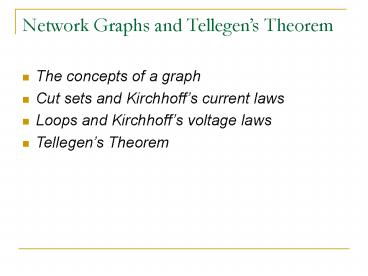Network Graphs and Tellegen - PowerPoint PPT Presentation
Title:
Network Graphs and Tellegen
Description:
Network Graphs and Tellegen s Theorem The concepts of a graph Cut sets and Kirchhoff s current laws Loops and Kirchhoff s voltage laws Tellegen s Theorem – PowerPoint PPT presentation
Number of Views:85
Avg rating:3.0/5.0
Title: Network Graphs and Tellegen
1
Network Graphs and Tellegens Theorem
- The concepts of a graph
- Cut sets and Kirchhoffs current laws
- Loops and Kirchhoffs voltage laws
- Tellegens Theorem
2
The concepts of a graph
The analysis of a complex circuit can be perform
systematically Using graph theories.
Graph consists of nodes and branches connected to
form a circuit.
Fig. 1
3
The concepts of a graph
Special graphs
Fig. 2
4
The concepts of a graph
- Subgraph
G1 is a subgraph of G if every node of G1 is the
node of G and every branch of G1 is the
branch of G
Fig. 3
5
The concepts of a graph
Associated reference directions
The kth branch voltage and kth branch current is
assigned as reference directions as shown in
fig. 4
Fig. 4
Graphs with assigned reference direction to all
branches are called oriented graphs.
6
The concepts of a graph
Fig. 5 Oriented graph
Branch 4 is incident with node 2 and node 3
Branch 4 leaves node 3 and enter node 2
7
The concepts of a graph
Incident matrix
The node-to-branch incident matrix Aa is a
rectangular matrix of nt rows and b columns whose
element aik defined by
If branch k leaves node i
If branch k enters node i
If branch k is not incident with node i
8
The concepts of a graph
For the graph of Fig.5 the incident matrix Aa is
9
Cutset and Kirchhoffs current law
If a connected graph were to partition the nodes
into two set by a closed gussian surface , those
branches are cut set and KCL applied to the cutset
Fig. 6 Cutset
10
Cutset and Kirchhoffs current law
A cutset is a set of branches that the removal of
these branches causes two separated parts but
any one of these branches makes the
graph connected.
An unconnected graph must have at least two
separate part.
Fig. 7
11
Cutset and Kirchhoffs current law
Fig. 8
12
Cutset and Kirchhoffs current law
Fig. 9
13
(c)
Fig. 9
14
Cutset and Kirchhoffs current law
- For any lumped network , for any of its cut sets,
and at any time, the algebraic sum of all branch
currents traversing the cut-set branches is zero.
From Fig. 9 (a)
for all
And from Fig. 9 (b)
for all
15
Cutset and Kirchhoffs current law
Cut sets should be selected such that they are
linearly independent.
III
Fig. 10
Cut sets I,II and III are linearly dependent
16
Cutset and Kirchhoffs current law
Cut set I
Cut set II
Cut set III
KCLcut set III KCLcut set I KCLcut set II
17
Loops and Kirchhoffs voltage laws
- A Loop L is a subgraph having closed path that
posses the following properties - The subgraph is connected
- Precisely two branches of L are incident with
each node
Fig. 11
18
Loops and Kirchhoffs voltage laws
Fig. 12
Cases I,II,III and IV violate the loop Case V
is a loop
19
Loops and Kirchhoffs voltage laws
- For any lumped network , for any of its loop, and
at any time, the algebraic sum of all branch
voltages around the loop is zero.
Example 1
Write the KVL for the loop shown in Fig 13
KVL
for all
Fig. 13
20
Tellegens Theorem
- Tellegens Theorem is a general network theorem
- It is valid for any lump network
For a lumped network whose element assigned by
associate reference direction for branch voltage
and branch current
The product is the power
delivered at time by the network to
the element
If all branch voltages and branch currents
satisfy KVL and KCL then
number of branch
21
Tellegens Theorem
Suppose that and
is another sets of branch
voltages and branch currents and if
and satisfy KVL and KCL
Then
and
22
Tellegens Theorem
- Applications
Tellegens Theorem implies the law of energy
conservation.
Since
The sum of power delivered by the independent
sources to the network is equal to the sum
of the power absorbed by all branches of the
network.
23
Applications
- Conservation of energy
- Conservation of complex power
- The real part and phase of driving point
impedance - Driving point impedance
24
Conservation of Energy
For all t
The sum of power delivered by the independent
sources to the network is equal to the sum
of the power absorbed by all branches of the
network.
25
Conservation of Energy
- Resistor
- Capacitor
- Inductor
For kth resistor
For kth capacitor
For kth inductor
26
Conservation of Complex Power
Branch Voltage Phasor
Branch Current Phasor
Branch Current Phasor Conjugate
27
(No Transcript)
28
Conservation of Complex Power
29
The real part and phase of driving point impedance
30
From Tellegens theorem, and let P complex
power delivered to the one-port by the source
31
Taking the real part
All impedances are calculated at the same
angular frequency i.e. the source angular
frequency
32
Driving Point Impedance
C
L
R
33
Exhibiting the real and imaginary part of P
Average power dissipated
Average Magnetic Energy Stored
Average Electric Energy Stored
34
From
35
Driving Point Impedance
- Given a linear time-invariant RLC network
driven by a sinusoidal current source of 1 A peak
amplitude and given that the network is in SS, - The driven point impedance seen by the source
has a real part twice the average power Pav and
an imaginary part that is 4w times the difference
of EM and EE































